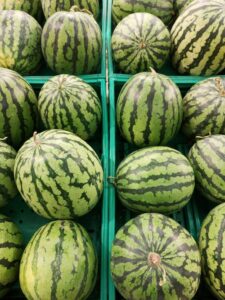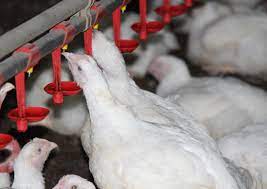How To Plant Watermelon Successfully In Nigeria

How To Plant Watermelon Successfully in Nigeria
Watermelon can be considered one of the most consumed vegetable crops in Nigeria. This is because of its unique sweetness and nutritional value that comes with it making the demands for it high. This demand has, however, encouraged many farmers into its cultivation which turned out to be very lucrative.
Watermelon farming is one of the most profitable untapped agribusinesses which is mostly ignored by farmers due to a lack of knowledge in cultivating it, thereby leaving this goldmine in the hands of a few who are well-grounded in this business. It is necessary to emphasize that before one jump into watermelon farming, it is very important to have all the necessary information and skills to be successful.
There are certain steps to take to succeed in this particular farming business and this article will give you detailed steps for you to be profitable. Here are the necessary steps:
Acquire Your Land:
Locating appropriate property for watermelon farming is the first step. Choose a spot that will provide the watermelon plants with six to eight hours of sunlight per day. Sufficient sunshine is necessary for fruit development and healthy growth.
A considerable amount of land is required to operate a watermelon farm. Make sure the soil has adequate drainage and fertility.
Land preparation
Clear the land of any grass and debris, and till the soil to make it loose and aerated. You can use a tractor or a hoe for this task.
Add organic matter such as aged manure, seaweed, compost, or green manure to the soil to improve its fertility and water retention.
Test the soil pH and adjust it if needed. Watermelons prefer a slightly acidic to neutral soil pH between 6.0 and 7.5. You can use lime to raise the pH or sulfur to lower it.
Make raised beds or ridges for planting the watermelon seeds or seedlings. This will help with drainage and prevent waterlogging. The beds or ridges should be about 1 meter wide and 15-20 cm high.
Use plastic mulch or straw mulch to cover the beds or ridges. This will prevent weed growth, conserve soil moisture, and keep the soil warm.
Make holes in the mulch about 2 meters apart for planting the seeds or seedlings. You can plant 2-3 seeds per hole and thin them later to one plant per hole4. Alternatively, you can transplant seedlings that are 3-4 weeks old and have 2-3 true leaves.
These are some of the basic steps for preparing the land for watermelon farming.
Prepare the Soil:
Soil preparation is crucial for successful watermelon cultivation. Start preparing the soil about 5 months before transplanting watermelon seedlings.
Plow the soil well to improve soil aeration and drainage. Watermelons grow best in loose, well-drained sandy loam soil with a pH between 5.5 and 7.1.
Select Watermelon Varieties:
There are many watermelon varieties available, including both seeded and seedless types.
Choose varieties that are well-suited to your climate and growing conditions.
Planting:
Plant watermelon seeds directly in the soil or start seedlings in pots under cover.
Transplant seedlings when they are about 3-4 weeks old.
Space the plants about 2-3 feet apart in rows with at least 6 feet between rows.
Fertilize and Irrigate:
Apply balanced fertilizers according to soil test recommendations. Watermelons require consistent moisture, especially during flowering and fruit development. Drip irrigation is ideal for efficient water management.
Weed Control:
Keep the area around watermelon plants weed-free. Mulching can help suppress weeds and retain soil moisture.
Pest and Disease Management:
Monitor for pests such as aphids, whiteflies, and cucumber beetles. Common diseases include powdery mildew, fusarium wilt, and anthracnose. Use appropriate pesticides or organic methods to control pests and diseases.
Harvesting:
Depending on the variety, watermelons are usually harvested 80–90 days after planting. When the fruit reaches full maturity, harvest it (observe for hollow sound when tapped, yellowing of the tendril opposite the stem, and dull rind color). When harvesting watermelons, handle them carefully to prevent damage. Promote Your watermelon Directly sell fresh watermelons to customers or via regional markets. Think about turning extra fruit into jam, juice, or other goods. Increase as Necessary: If you have enough land, you might want to think about gradually growing your watermelon farm.
Watermelon farming can be profitable if done correctly and managed. Recall that although beginning a
watermelon farm demands commitment, done right, it can result in substantial returns on investment.
How to Start Snail Farming at Home
Factors affecting profitable watermelon in Nigeria.
Profitable watermelon farming in Nigeria is influenced by many factors, such as climate, soil, variety, irrigation, pest and disease management, fertilization, weed control, harvesting, and marketing. Here are some of the main points you should know about each factor:
Climate: Watermelons need a warm and long growing season with temperatures between 24°C and 29°C. They also need adequate rainfall and sunlight for optimal growth and yield1.
Soil: Watermelons prefer well-drained soil with a pH level between 6 and 7, rich in organic matter. You can improve soil fertility by adding manure, compost, or green manure to the soil.
Variety: You should choose a watermelon variety that suits your market demand, taste preference, and disease resistance. For example, seedless watermelons are popular among consumers because they are convenient and have a longer shelf life.
Irrigation: Watermelons have high water requirements and need proper irrigation techniques to ensure sufficient moisture without wastage. Drip irrigation or furrow irrigation are recommended methods for watermelon farming.
Pest and disease management: You should implement integrated pest management (IPM) techniques to prevent and control pests and diseases that can reduce your yield and quality. IPM involves using crop rotation, biological control, and judicious use of pesticides.
Fertilization: You should conduct soil tests to determine the nutrient deficiencies in your soil and apply the correct amount of fertilizers accordingly. You can also use organic fertilizers or compost to enhance crop productivity.
Weed control: You should employ effective weed control measures to minimize weed competition with your watermelon plants. You can use mulching, mechanical cultivation, or herbicide application to control weeds.
Harvesting: You should harvest your watermelons at the right time and handle them carefully to maintain their quality and market value. You can use advanced harvesting techniques such as assessing fruit maturity, avoiding physical damage, and storing them properly.
Marketing: You should identify your target market, establish relationships with buyers, and promote your farm’s brand to capture higher prices and secure consistent sales.
Watermelon is a delicious and refreshing fruit that has many health benefits. Some of the benefits of watermelon are:
It helps you stay hydrated. Watermelon is 92% water, which can help quench your thirst and prevent dehydration. Eating watermelon after exercise can also replenish your electrolytes and carbohydrates1.
It is packed with nutrients and antioxidants. Watermelon contains vitamins A and C, potassium, magnesium, and citrulline, which are important for your health. It also has lycopene and cucurbitacin E, which are antioxidants that may protect your cells from damage and reduce the risk of chronic diseases.
It supports heart health. Watermelon may lower blood pressure and cholesterol levels, which are risk factors for heart disease. Lycopene, in particular, may improve blood flow and prevent plaque buildup in the arteries.
It reduces muscle soreness. Watermelon may help relieve muscle pain and soreness after exercise. This is because citrulline, an amino acid in watermelon, may improve blood circulation and reduce muscle fatigue.
It aids weight management. Watermelon is low in calories and high in water and fiber, which can help you feel full and eat less. Watermelon may also boost your metabolism and fat burning, as well as prevent fat accumulation in the body.
It improves digestion. Watermelon is rich in water and fiber, which can help prevent constipation and promote regular bowel movements. Watermelon may also have a laxative effect, as it contains sorbitol, a sugar alcohol that can stimulate the intestines14.
It protects your skin. Watermelon can help keep your skin healthy and youthful, as it contains vitamin C, lycopene, and beta-carotene. These nutrients can protect your skin from sun damage, inflammation, and aging signs23.
These are some of the health benefits of watermelon. You can enjoy this fruit fresh, frozen, juiced, or blended into smoothies or salads. Watermelon is also a great ingredient for desserts, such as popsicles, sorbets, or cakes
Watermelon can be considered one of the most consumed vegetable crops in Nigeria. This is because of its unique sweetness and nutritional value that comes with it making the demands for it high. This demand has, however, encouraged many farmers into its cultivation which turned out to be very lucrative.
Watermelon farming is one of the most profitable untapped agribusinesses which is mostly ignored by farmers due to a lack of knowledge in cultivating it, thereby leaving this goldmine in the hands of a few who are well-grounded in this business. It is necessary to emphasize that before one jump into watermelon farming, it is very important to have all the necessary information and skills to be successful.
There are certain steps to take to succeed in this particular farming business and this article will give you detailed steps for you to be profitable. Here are the necessary steps:
Acquire Your Land:
Locating appropriate property for watermelon farming is the first step. Choose a spot that will provide the watermelon plants with six to eight hours of sunlight per day. Sufficient sunshine is necessary for fruit development and healthy growth.
A considerable amount of land is required to operate a watermelon farm. Make sure the soil has adequate drainage and fertility.
Land preparation
Clear the land of any grass and debris, and till the soil to make it loose and aerated. You can use a tractor or a hoe for this task.
Add organic matter such as aged manure, seaweed, compost, or green manure to the soil to improve its fertility and water retention.
Test the soil pH and adjust it if needed. Watermelons prefer a slightly acidic to neutral soil pH between 6.0 and 7.5. You can use lime to raise the pH or sulfur to lower it.
Make raised beds or ridges for planting the watermelon seeds or seedlings. This will help with drainage and prevent waterlogging. The beds or ridges should be about 1 meter wide and 15-20 cm high.
Use plastic mulch or straw mulch to cover the beds or ridges. This will prevent weed growth, conserve soil moisture, and keep the soil warm.
Make holes in the mulch about 2 meters apart for planting the seeds or seedlings. You can plant 2-3 seeds per hole and thin them later to one plant per hole4. Alternatively, you can transplant seedlings that are 3-4 weeks old and have 2-3 true leaves.
These are some of the basic steps for preparing the land for watermelon farming.
Prepare the Soil:
Soil preparation is crucial for successful watermelon cultivation. Start preparing the soil about 5 months before transplanting watermelon seedlings.
Plow the soil well to improve soil aeration and drainage. Watermelons grow best in loose, well-drained sandy loam soil with a pH between 5.5 and 7.1.
Select Watermelon Varieties:
There are many watermelon varieties available, including both seeded and seedless types.
Choose varieties that are well-suited to your climate and growing conditions.
Planting:
Plant watermelon seeds directly in the soil or start seedlings in pots under cover.
Transplant seedlings when they are about 3-4 weeks old.
Space the plants about 2-3 feet apart in rows with at least 6 feet between rows.
Fertilize and Irrigate:
Apply balanced fertilizers according to soil test recommendations. Watermelons require consistent moisture, especially during flowering and fruit development. Drip irrigation is ideal for efficient water management.
Weed Control:
Keep the area around watermelon plants weed-free. Mulching can help suppress weeds and retain soil moisture.
Pest and Disease Management:
Monitor for pests such as aphids, whiteflies, and cucumber beetles. Common diseases include powdery mildew, fusarium wilt, and anthracnose. Use appropriate pesticides or organic methods to control pests and diseases.
Harvesting:
Depending on the variety, watermelons are usually harvested 80–90 days after planting. When the fruit reaches full maturity, harvest it (observe for hollow sound when tapped, yellowing of the tendril opposite the stem, and dull rind color). When harvesting watermelons, handle them carefully to prevent damage. Promote Your watermelon Directly sell fresh watermelons to customers or via regional markets. Think about turning extra fruit into jam, juice, or other goods. Increase as Necessary: If you have enough land, you might want to think about gradually growing your watermelon farm.
Watermelon farming can be profitable if done correctly and managed. Recall that although beginning a watermelon farm demands commitment, done right, it can result in substantial.
returns on investment.
Factors affecting profitable watermelon in Nigeria.
Profitable watermelon farming in Nigeria is influenced by many factors, such as climate, soil, variety, irrigation, pest and disease management, fertilization, weed control, harvesting, and marketing. Here are some of the main points you should know about each factor:
Climate: Watermelons need a warm and long growing season with temperatures between 24°C and 29°C. They also need adequate rainfall and sunlight for optimal growth and yield1.
Soil: Watermelons prefer well-drained soil with a pH level between 6 and 7, rich in organic matter. You can improve soil fertility by adding manure, compost, or green manure to the soil.
Variety: You should choose a watermelon variety that suits your market demand, taste preference, and disease resistance. For example, seedless watermelons are popular among consumers because they are convenient and have a longer shelf life.
Irrigation: Watermelons have high water requirements and need proper irrigation techniques to ensure sufficient moisture without wastage. Drip irrigation or furrow irrigation are recommended methods for watermelon farming.
Pest and disease management: You should implement integrated pest management (IPM) techniques to prevent and control pests and diseases that can reduce your yield and quality. IPM involves using crop rotation, biological control, and judicious use of pesticides.
Fertilization: You should conduct soil tests to determine the nutrient deficiencies in your soil and apply the correct amount of fertilizers accordingly. You can also use organic fertilizers or compost to enhance crop productivity.
Weed control: You should employ effective weed control measures to minimize weed competition with your watermelon plants. You can use mulching, mechanical cultivation, or herbicide application to control weeds.
Harvesting: You should harvest your watermelons at the right time and handle them carefully to maintain their quality and market value. You can use advanced harvesting techniques such as assessing fruit maturity, avoiding physical damage, and storing them properly.
Marketing: You should identify your target market, establish relationships with buyers, and promote your farm’s brand to capture higher prices and secure consistent sales.

Benefits of Watermelon
Watermelon is a delicious and refreshing fruit that has many health benefits. Some of the benefits of watermelon are:
It helps you stay hydrated. Watermelon is 92% water, which can help quench your thirst and prevent dehydration. Eating watermelon after exercise can also replenish your electrolytes and carbohydrates1.
It is packed with nutrients and antioxidants. Watermelon contains vitamins A and C, potassium, magnesium, and citrulline, which are important for your health. It also has lycopene and cucurbitacin E, which are antioxidants that may protect your cells from damage and reduce the risk of chronic diseases.
It supports heart health. Watermelon may lower blood pressure and cholesterol levels, which are risk factors for heart disease. Lycopene, in particular, may improve blood flow and prevent plaque buildup in the arteries.
It reduces muscle soreness. Watermelon may help relieve muscle pain and soreness after exercise. This is because citrulline, an amino acid in watermelon, may improve blood circulation and reduce muscle fatigue.
It aids weight management. Watermelon is low in calories and high in water and fiber, which can help you feel full and eat less. Watermelon may also boost your metabolism and fat burning, as well as prevent fat accumulation in the body.
It improves digestion. Watermelon is rich in water and fiber, which can help prevent constipation and promote regular bowel movements. Watermelon may also have a laxative effect, as it contains sorbitol, a sugar alcohol that can stimulate the intestines14.
It protects your skin. Watermelon can help keep your skin healthy and youthful, as it contains vitamin C, lycopene, and beta-carotene. These nutrients can protect your skin from sun damage, inflammation, and aging signs23.
These are some of the health benefits of watermelon. You can enjoy this fruit fresh, frozen, juiced, or blended into smoothies or salads. Watermelon is also a great ingredient for desserts, such as popsicles, sorbets, or cakes.








